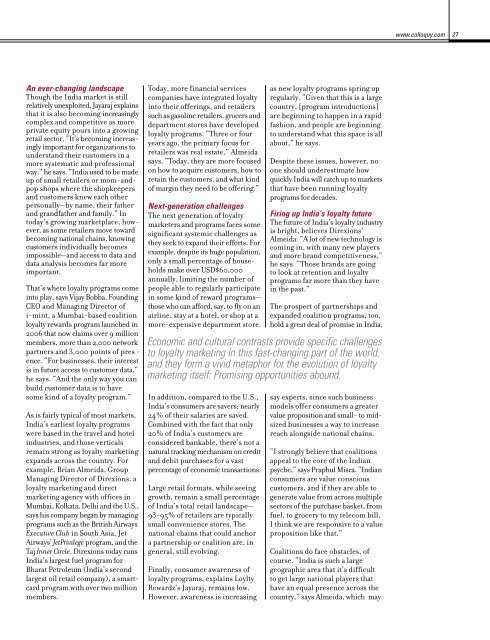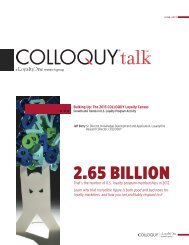Transformers - Colloquy
Transformers - Colloquy
Transformers - Colloquy
Create successful ePaper yourself
Turn your PDF publications into a flip-book with our unique Google optimized e-Paper software.
An ever-changing landscape<br />
Though the India market is still<br />
relatively unexploited, Jayaraj explains<br />
that it is also becoming increasingly<br />
complex and competitive as more<br />
private equity pours into a growing<br />
retail sector. “It’s becoming increas -<br />
ingly important for organizations to<br />
understand their customers in a<br />
more systematic and professional<br />
way,” he says. “India used to be made<br />
up of small retailers or mom-andpop<br />
shops where the shopkeepers<br />
and customers knew each other<br />
personally—by name, their father<br />
and grandfather and family.” In<br />
today’s growing marketplace, however,<br />
as some retailers move toward<br />
becoming national chains, knowing<br />
customers individually becomes<br />
impossible—and access to data and<br />
data analysis becomes far more<br />
important.<br />
That’s where loyalty programs come<br />
into play, says Vijay Bobba, Founding<br />
CEO and Managing Director of<br />
i-mint, a Mumbai-based coalition<br />
loyalty rewards program launched in<br />
2006 that now claims over 9 million<br />
members, more than 2,000 network<br />
partners and 3,000 points of pres -<br />
ence. “For businesses, their interest<br />
is in future access to customer data,”<br />
he says. “And the only way you can<br />
build customer data is to have<br />
some kind of a loyalty program.”<br />
As is fairly typical of most markets,<br />
India’s earliest loyalty programs<br />
were based in the travel and hotel<br />
industries, and those verticals<br />
remain strong as loyalty marketing<br />
expands across the country. For<br />
example, Brian Almeida, Group<br />
Managing Director of Direxions, a<br />
loyalty marketing and direct<br />
marketing agency with offices in<br />
Mumbai, Kolkata, Delhi and the U.S.,<br />
says his company began by managing<br />
programs such as the British Airways<br />
Executive Club in South Asia, Jet<br />
Airways’ JetPrivilege program, and the<br />
Taj Inner Circle. Direxions today runs<br />
India’s largest fuel program for<br />
Bharat Petroleum (India’s second<br />
largest oil retail company), a smartcard<br />
program with over two million<br />
members.<br />
Today, more financial services<br />
companies have integrated loyalty<br />
into their offerings, and retailers<br />
such as gasoline retailers, grocers and<br />
department stores have developed<br />
loyalty programs. “Three or four<br />
years ago, the primary focus for<br />
retailers was real estate,” Almeida<br />
says. “Today, they are more focused<br />
on how to acquire customers, how to<br />
retain the customers, and what kind<br />
of margin they need to be offering.”<br />
Next-generation challenges<br />
The next generation of loyalty<br />
marketers and programs faces some<br />
significant systemic challenges as<br />
they seek to expand their efforts. For<br />
example, despite its huge population,<br />
only a small percentage of house -<br />
holds make over USD$60,000<br />
annually, limiting the number of<br />
people able to regularly participate<br />
in some kind of reward programs—<br />
those who can afford, say, to fly on an<br />
airline, stay at a hotel, or shop at a<br />
more-expensive department store.<br />
In addition, compared to the U.S.,<br />
India’s consumers are savers; nearly<br />
24% of their salaries are saved.<br />
Combined with the fact that only<br />
20% of India’s customers are<br />
considered bankable, there’s not a<br />
natural tracking mechanism on credit<br />
and debit purchases for a vast<br />
percentage of economic transactions.<br />
Large retail formats, while seeing<br />
growth, remain a small percentage<br />
of India’s total retail landscape—<br />
93-95% of retailers are typically<br />
small convenience stores. The<br />
national chains that could anchor<br />
a partnership or coalition are, in<br />
general, still evolving.<br />
Finally, consumer awareness of<br />
loyalty programs, explains Loylty<br />
Rewardz’s Jayaraj, remains low.<br />
However, awareness is increasing<br />
as new loyalty programs spring up<br />
regularly. “Given that this is a large<br />
country, [program introductions]<br />
are beginning to happen in a rapid<br />
fashion, and people are beginning<br />
to understand what this space is all<br />
about,” he says.<br />
Despite these issues, however, no<br />
one should underestimate how<br />
quickly India will catch up to markets<br />
that have been running loyalty<br />
programs for decades.<br />
Firing up India’s loyalty future<br />
The future of India’s loyalty industry<br />
is bright, believes Direxions’<br />
Almeida. “A lot of new technology is<br />
coming in, with many new players<br />
and more brand competitiveness,”<br />
he says. “Those brands are going<br />
to look at retention and loyalty<br />
programs far more than they have<br />
in the past.”<br />
The prospect of partnerships and<br />
expanded coalition programs, too,<br />
hold a great deal of promise in India,<br />
Economic and cultural contrasts provide specific challenges<br />
to loyalty marketing in this fast-changing part of the world,<br />
and they form a vivid metaphor for the evolution of loyalty<br />
marketing itself: Promising opportunities abound.<br />
say experts, since such business<br />
models offer consumers a greater<br />
value proposition and small- to midsized<br />
businesses a way to increase<br />
reach alongside national chains.<br />
“I strongly believe that coalitions<br />
appeal to the core of the Indian<br />
psyche,” says Praphul Misra. “Indian<br />
consumers are value conscious<br />
customers, and if they are able to<br />
generate value from across multiple<br />
sectors of the purchase basket, from<br />
fuel, to grocery to my telecom bill,<br />
I think we are responsive to a value<br />
proposition like that.”<br />
Coalitions do face obstacles, of<br />
course. “India is such a large<br />
geographic area that it’s difficult<br />
to get large national players that<br />
have an equal presence across the<br />
country,” says Almeida, which may<br />
www.colloquy.com<br />
27




